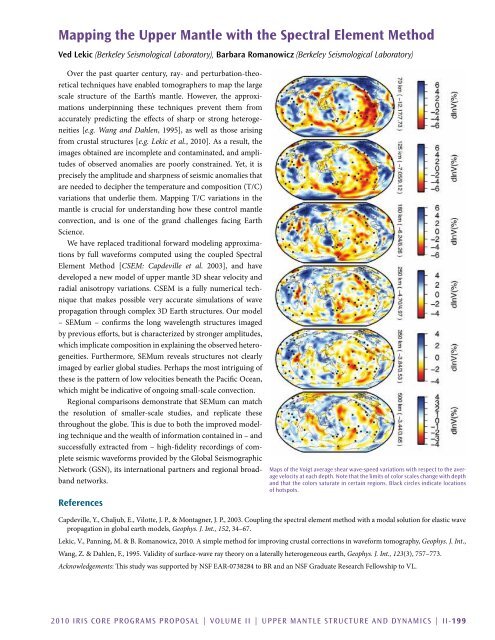Download Volume II Accomplisments (28 Mb pdf). - IRIS
Download Volume II Accomplisments (28 Mb pdf). - IRIS
Download Volume II Accomplisments (28 Mb pdf). - IRIS
You also want an ePaper? Increase the reach of your titles
YUMPU automatically turns print PDFs into web optimized ePapers that Google loves.
Mapping the Upper Mantle with the Spectral Element Method<br />
Ved Lekic (Berkeley Seismological Laboratory), Barbara Romanowicz (Berkeley Seismological Laboratory)<br />
Over the past quarter century, ray- and perturbation-theoretical<br />
techniques have enabled tomographers to map the large<br />
scale structure of the Earth’s mantle. However, the approximations<br />
underpinning these techniques prevent them from<br />
accurately predicting the effects of sharp or strong heterogeneities<br />
[e.g. Wang and Dahlen, 1995], as well as those arising<br />
from crustal structures [e.g. Lekic et al., 2010]. As a result, the<br />
images obtained are incomplete and contaminated, and amplitudes<br />
of observed anomalies are poorly constrained. Yet, it is<br />
precisely the amplitude and sharpness of seismic anomalies that<br />
are needed to decipher the temperature and composition (T/C)<br />
variations that underlie them. Mapping T/C variations in the<br />
mantle is crucial for understanding how these control mantle<br />
convection, and is one of the grand challenges facing Earth<br />
Science.<br />
We have replaced traditional forward modeling approximations<br />
by full waveforms computed using the coupled Spectral<br />
Element Method [CSEM: Capdeville et al. 2003], and have<br />
developed a new model of upper mantle 3D shear velocity and<br />
radial anisotropy variations. CSEM is a fully numerical technique<br />
that makes possible very accurate simulations of wave<br />
propagation through complex 3D Earth structures. Our model<br />
– SEMum – confirms the long wavelength structures imaged<br />
by previous efforts, but is characterized by stronger amplitudes,<br />
which implicate composition in explaining the observed heterogeneities.<br />
Furthermore, SEMum reveals structures not clearly<br />
imaged by earlier global studies. Perhaps the most intriguing of<br />
these is the pattern of low velocities beneath the Pacific Ocean,<br />
which might be indicative of ongoing small-scale convection.<br />
Regional comparisons demonstrate that SEMum can match<br />
the resolution of smaller-scale studies, and replicate these<br />
throughout the globe. This is due to both the improved modeling<br />
technique and the wealth of information contained in – and<br />
successfully extracted from – high-fidelity recordings of complete<br />
seismic waveforms provided by the Global Seismographic<br />
Network (GSN), its international partners and regional broadband<br />
networks.<br />
References<br />
Maps of the Voigt average shear wave-speed variations with respect to the average<br />
velocity at each depth. Note that the limits of color scales change with depth<br />
and that the colors saturate in certain regions. Black circles indicate locations<br />
of hotspots.<br />
Capdeville, Y., Chaljub, E., Vilotte, J. P., & Montagner, J. P., 2003. Coupling the spectral element method with a modal solution for elastic wave<br />
propagation in global earth models, Geophys. J. Int., 152, 34–67.<br />
Lekic, V., Panning, M. & B. Romanowicz, 2010. A simple method for improving crustal corrections in waveform tomography, Geophys. J. Int.,<br />
Wang, Z. & Dahlen, F., 1995. Validity of surface-wave ray theory on a laterally heterogeneous earth, Geophys. J. Int., 123(3), 757–773.<br />
Acknowledgements: This study was supported by NSF EAR-0738<strong>28</strong>4 to BR and an NSF Graduate Research Fellowship to VL.<br />
2010 <strong>IRIS</strong> Core Programs Proposal | <strong>Volume</strong> <strong>II</strong> | Upper Mantle Structure and Dynamics | <strong>II</strong>-199
















